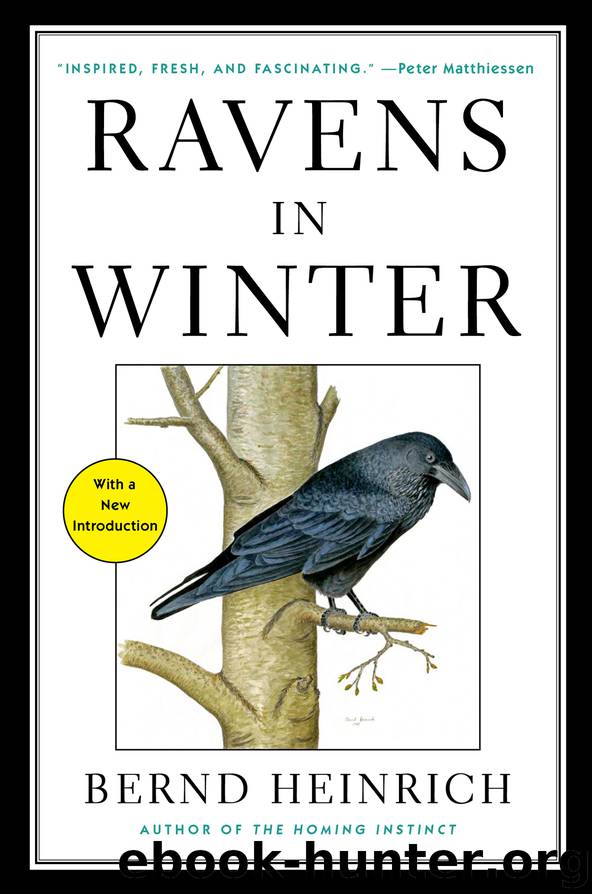Ravens in Winter by Bernd Heinrich

Author:Bernd Heinrich
Language: eng
Format: epub
Publisher: Simon & Schuster
* * *
* * *
COURTING AND DISPLAYS
FINDING AND WINNING a proper mate is an important event, which many animals execute with considerable energy and inventive expertise. In many birds, especially those of the tropics, females assess a male’s eligibility and usefulness for future offspring by some “useless” characteristic: having the ability, for example, to endure doing foolish and lengthy exercises without stopping to feed; making a lot of noise; possessing brightly colored but functionally useless feathers; or spending time courting while others must forage for a living. These characteristics are, however, an indirect measure of genetic quality, because they may represent overall vigor, which offspring would inherit. A female can, in choosing the male (or vice versa), also utilize his behavior to directly benefit herself or her offspring, rather than gamble that there is substance or some beneficial future promise behind his present extravagance.
Some females can raise a family without a male’s help, but a female raven is utterly dependent on her male for food for over a month of every year. As one might expect in birds who rely on their mates to feed them and their young, evolution has provided safeguards in the courting behavior that help a female assess whether or not a suitor is going to be a good provider. It is done by a very “clever” ploy. During courtship the female acts like a helpless fledgling, mimicking both the behavior and voice of the begging young. The evolutionary rationale is that if the male can provide for her when she mimics a fledgling, he can probably provide later for her and hers as well. But this is not just a test, because the females in many diverse species need to be fed, and at this point in the evolutionary game neither parent can produce young unless the male feeds his mate.
Whether or not a male can actually provide directly or indirectly for his offspring depends on many tightly interrelated things, such as his vigor, the quality of his territory, his dominance, and in ravens possibly also his recruitment behavior! Almost nothing is known about the basis on which ravens choose mates. We can only make intelligent guesses based on the well-developed theory of mate choice as it applies to other birds. One thing is sure, part of the choice is, at least in the immediate sense, related to displays that draw attention to suitors.
In many birds, males and females are easily distinguished from each other by plumage, voice, and behavior. In ravens the sexes look alike (males tend to be larger than females, but there is overlap) and to our undiscerning ears and eyes may sound and behave nearly identically. Nevertheless, there must be differences, and I will try to unravel some of the confusing and not very well-known details of courting as it relates to ravens.
The sexual display ceremonies of the raven are described and illustrated in Franklin Coombs’s and Derek Goodwin’s books on corvids, but their information is derived primarily from Konrad Lorenz’s observations of one pair in 1932.
Download
This site does not store any files on its server. We only index and link to content provided by other sites. Please contact the content providers to delete copyright contents if any and email us, we'll remove relevant links or contents immediately.
The Lonely City by Olivia Laing(4715)
Animal Frequency by Melissa Alvarez(4370)
All Creatures Great and Small by James Herriot(4197)
Walking by Henry David Thoreau(3864)
Exit West by Mohsin Hamid(3748)
Origin Story: A Big History of Everything by David Christian(3595)
COSMOS by Carl Sagan(3519)
How to Read Water: Clues and Patterns from Puddles to the Sea (Natural Navigation) by Tristan Gooley(3376)
Hedgerow by John Wright(3244)
How to Read Nature by Tristan Gooley(3217)
The Inner Life of Animals by Peter Wohlleben(3206)
How to Do Nothing by Jenny Odell(3204)
Project Animal Farm: An Accidental Journey into the Secret World of Farming and the Truth About Our Food by Sonia Faruqi(3145)
Origin Story by David Christian(3121)
Water by Ian Miller(3093)
A Forest Journey by John Perlin(3012)
The Plant Messiah by Carlos Magdalena(2843)
A Wilder Time by William E. Glassley(2795)
Forests: A Very Short Introduction by Jaboury Ghazoul(2768)
